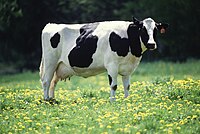
Photo from wikipedia
Mastitis, inflammation of the mammary gland, is often caused by intramammary infection with bacterial organisms. It impacts on dairy cattle welfare, production, udder health and longevity in the herd. Current… Click to show full abstract
Mastitis, inflammation of the mammary gland, is often caused by intramammary infection with bacterial organisms. It impacts on dairy cattle welfare, production, udder health and longevity in the herd. Current detection methods for mammary inflammation and infection all have limitations, particularly for on-farm diagnosis of non-clinical mastitis after calving. Acute phase proteins have been suggested as alternative early indicators of the disease and can potentially be used as cow-side test with results in real time. In this study, milk haptoglobin concentrations were investigated over the first week postpartum to explore haptoglobin's potential as indicator of udder health in dairy heifers. Haptoglobin concentration was highest on day 3 of lactation, and was positively correlated with somatic cell count, a commonly used marker of inflammation (rs=0.68). Haptoglobin level was also associated with bacteriological culture results, a key indicator of infection status, whereby median haptoglobin concentration on days 3 and 5 was higher in quarters that were infected at calving than quarters that were non infected at calving. Sensitivity and specificity of haptoglobin concentration as indicator of infection were low, both for lenient and strict culture-based definitions of intramammary infection (57 or 60% and 61 or 63%, respectively). Although haptoglobin was a poor biomarker for intramammary infection with coagulase negative staphylococci in heifers during the first week after calving, it may have value as an indicator of major pathogen infections, particularly in large scale dairy herds where pre-partum heifers are managed off-site.
Journal Title: Research in veterinary science
Year Published: 2018
Link to full text (if available)
Share on Social Media: Sign Up to like & get
recommendations!